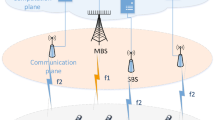Abstract
The deployment of ultra-dense heterogeneous networks (HetNets) are envisioned as the essentials to embrace of intelligent applications for the next-generation wireless networks. For ultra-dense HetNets, the small scale heterogeneous edge servers in macrocell and smallcell, decreasing downlink and uplink communication delay should be attracted more attention for latency-critical intelligent applications. Therefore, we aim at edge computation offloading of joint downlink (DL) and uplink (UL) together with communication and computing resource allocation. Then, we formulate the computation offloading optimization problem into minimizing the overall delay of task while saving energy consumption of user device. However,the joint downlink and uplink computing offloading problem with resource allocation is a mixed binary integer programming which is difficult to deal with. We convert the programming problem into resource allocation sub-problem and computing offloading sub-problem, and propose an efficient joint downlink and uplink offloading algorithm for ultra-dense HetNets. Numerical results validate the efficiency of the proposed algorithm in terms of the delay and energy saving of system.





Similar content being viewed by others
References
Dong Z, Liu Y, Zhou H, et al (2017) An energy-efficient offloading framework with predictable temporal correctness. In: Proc ACM/IEEE symposium on edge computing (SEC), San Jose / Silicon Valley, CA, USA, October 12-14, pp 1–12
Guenter Klas (2017) Edge computing and the role of cellular networks. Computer 50(10):40–49
Shi W, Cao J, Zhang Q, et al (2016) Edge computing: vision and challenges. IEEE Internet Things J 3(5):637–646
Mouradian C, Naboulsi D, Yangui S, et al (2018) A comprehensive survey on fog computing: state-of-the-art and research challenges. IEEE Commun Surv Tutorials 20(1):416–464
Sun Y, Zhou S, Xu J (2017) EMM: energy-aware management for mobile edge computing in ultra dense networks. IEEE J Sel Areas Commun 35(11):2637–2646
Dinh HT, Lee C, Niyato D, et al (2013) A survey of mobile cloud computing: architecture, applications, and approaches. Wirel Commun Mob Comput 13(18):1587–1611
Hu YC, Patel M, Sabella D, et al (2015) Mobile edge computingA key technology towards 5G. ETSI White Paper :1–16
Du J, Gelenbe E, Jiang C, et al (2017) Contract design for traffic offloading and resource allocation in heterogeneous Ultra-Dense networks. IEEE J Sel Areas Commun 35(11):2457–2467
Zheng J, Li J, Wang N, et al (2017) Joint load balancing of downlink and uplink for eICIC in heterogeneous network. IEEE Trans Veh Technol 66(7):6388–6398
Ksentini A, Taleb T, Chen M (2014) A Markov decision process-based service migration procedure for follow me cloud. In: Proc IEEE international conference on communications (ICC), pp 1350–1354
Chen M, Hao Y, Li Y, et al (2015) On the computation offloading at ad hoc cloudlet: architecture and service modes. IEEE Commun Mag 53(6):18–24
Tong L, Li Y, Gao W (2016) A hierarchical edge cloud architecture for mobile computing. In: Proc international conference on computer communications (INFOCOM), pp 1–9
Chen X, Jiao L, Li W, et al (2016) Efficient multi-user computation offloading for mobile-edge cloud computing. IEEE/ACM Trans Network 24(5):2795–2808
Xiao Y, Krunz M (2017) Qoe and power efficiency tradeoff for fog computing networks with fog node cooperation. In: Proc international conference on computer communications (INFOCOM), pp 1–9
Chen M, Dong M, Liang B, et al (2018) Resource sharing of a computing access point for multi-user mobile cloud offloading with delay constraints. IEEE Trans Mob Comput 17(12):2868–2881
Chen M, Hao Y, Qiu M, et al (2016) Mobility aware caching and computation offloading in 5G ultra-dense cellular networks. Sensors 16(7):974
Mao Y, Zhang J, Song SH, et al (2017) Stochastic joint radio and computational resource management for multi-user mobile-edge computing systems. IEEE Trans Wirel Commun 16(9):5994– 6009
Chen M, Dong M, Liang B, et al (2016) Joint offloading decision and resource allocation for mobile cloud with computing access point. International Conference on Acoustics, Speech, and Signal Processing :3516–3520
Guo H, Liu J, Zhang J et al Mobile-edge computation offloading for ultra-dense IoT networks, IEEE Internet Things J. https://doi.org/10.1109/JIOT.2018.2838584
Chen M, Hao Y (2018) Task offloading for mobile edge computing in software defined ultra-dense network. IEEE J Sel Areas Commun 36(3):1–11
Boostanimehr H, Bhargava VK (2015) Joint Downlink and uplink aware cell association in HetNets with QoS provisioning[J]. IEEE Trans Wirel Commun 14(10):5388–5401
Yao Q, Quek TQS, Huang A, et al (2017) Joint downlink and uplink energy minimization in wet-enabled networks. IEEE Trans Wirel Commun 16(10):6751–6765
Wang C, Yu FR, Liang C, et al (2017) Joint computation offloading and interference management in wireless cellular networks with mobile edge computing. IEEE Trans Veh Technol 66(8):7432–7445
Pochet Y, Wolsey LA (2006) Production planning by mixed integer programming. Springer, Berlin
Boyd S, Vandenberghe L (2004) Convex optimization. Cambridge University Press, Cambridge
Grant B, Boyd S (2011) CVX: matlab software for disciplined convex programming, http://cvxr.com/cvx/
Liu Y, Niu D, Li B (2016) Delay-optimized video traffic routing in software-defined interdatacenter networks. IEEE Trans Multimedia 18(5):865–878
Luenberger DG (1973) Introduction to linear and nonlinear programming. Addison-Wesley, Reading
Acknowledgements
This work was supported in part by the National Natural Science Foundation of China (61701400, 61502387, 61503300, 41601353, 61572401 and 61672426), by Project Funded by China Postdoctoral Science Foundation (2017M613188), by Natural Science Basic Research Plan in Shaanxi Province of China (2017JQ6052, 2017JQ4003 and 17JK0783).
Author information
Authors and Affiliations
Corresponding authors
Additional information
Publisher’s Note
Springer Nature remains neutral with regard to jurisdictional claims in published maps and institutional affiliations.
Rights and permissions
About this article
Cite this article
Zheng, J., Gao, L., Wang, H. et al. Joint Downlink and Uplink Edge Computing Offloading in Ultra-Dense HetNets. Mobile Netw Appl 24, 1452–1460 (2019). https://doi.org/10.1007/s11036-019-01274-y
Published:
Issue Date:
DOI: https://doi.org/10.1007/s11036-019-01274-y




